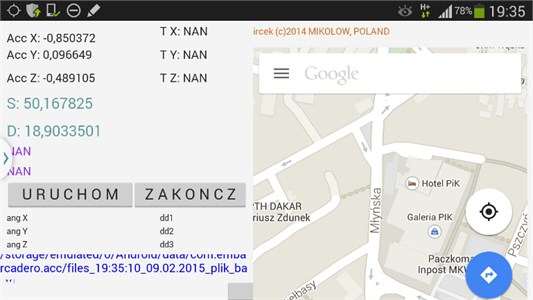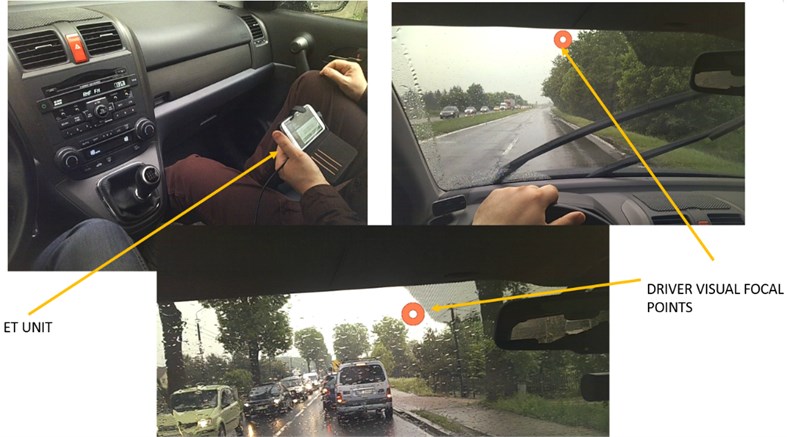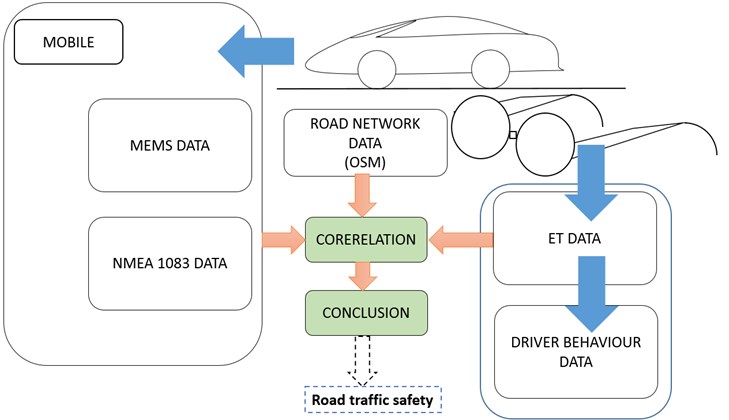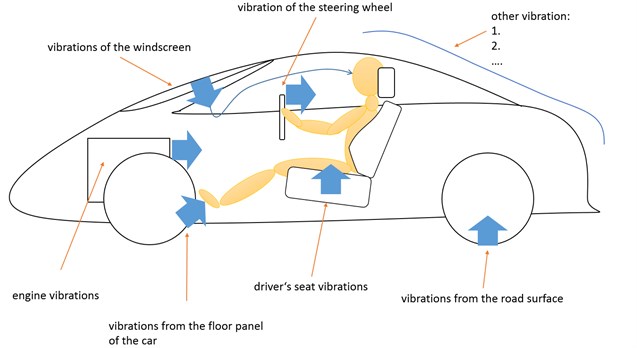Abstract
The article provides a discussion on the results of studies conducted in a road network of both Silesian and Lesser Poland Voivodeship. The goal of the research in question was to establish relationships between vibrations of an automotive vehicle and its driver’s behaviour. For that purpose, the test vehicle was equipped with a linear acceleration recording device and a GPS signal receiver.
1. Introduction
Perception and scope of the vibration exposure on human, especially in means of transport, are very large. Consequences of the human exposure to vibrations include various harmful changes occurring in the organism. They have a direct or indirect influence on driver behavior and in consequence on comfort and safety. Mechanical vibrations occurring in a working environment may be classified as general vibrations, i.e. those affecting the human organism via lower extremities, the pelvis and the back. The second category comprises local vibrations affecting the human organism through upper limbs. It allows to describe the vibration affecting on the human as Hand-Arm Vibration (HAV) and Whole-Body Vibration (WBV) [1-3].
A very large group of people exposed to general vibrations comprises car drivers, passengers, tram drivers or building and road machinery operators. Occupations that require driving long distances or operating heavy equipment expose workers daily to low-frequency vibrations generally less than 100 Hz. Exposure to these vibrations can cause serious physical problems ranging from chronic back pain to nerve damage. Whole-body vibration is caused by twisted sitting postures combined with vibration. The combination increases stress and load on the neck, shoulder and lower back.
It is more and more common that vibrations, being undesirable residual phenomena, are used in machinery monitoring and diagnostics [4-10].
2. Experimental research
The experimental research was conducted as studies in a road network of both Silesian and Lesser Poland Voivodeship. The smartphone used in the studies featured both systems, i.e. MEMS and GPS. Nearly every mobile phone representing the segment of cheap and popular portable devices offers such functionality. The purpose of microelectromechanical systems (MEMS) in the study discussed was to measure linear accelerations, whereas the GPS receiver was used to record the vehicle position in physical space. In order to read the data received from both measuring systems, a mobile application dedicated developed by the authors for the Android platform was installed on the phone. The graphical layout of the application has been illustrated in Fig. 1. Besides accelerations and the geographic position of the vehicle, also its speed and altitude above sea level were read using the data provided by the GPS in a format conforming to the NMEA 0183 standard. Linear accelerations were measured in an interval of 10 ms.
In order to record the vehicle driver’s behaviours in the course of the study, the vehicle was equipped with the eye tracking system enabling vision parameters to be monitored. The system used in the studies was manufactured by SMI, and it scanned the vehicle driver’s vision parameters by conducting measurements of both eyes simultaneously with the frequency of 60 Hz. This frequency allows for optimum matching of the accelerometer indications with the vision parameter readings. Such a solution as the eye tracking device makes it possible to track the vehicle driver’s gaze points in a 3D space of the road network. The data recording device (without glasses) has been illustrated in Fig. 2. Besides the option of measuring the path of gaze at the road and its surroundings (as well as other characteristics of vision, e.g. blinking time), such a system enables observation of elements of the dashboard used by the driver while operating the vehicle as well as individual pedals, levers and the steering wheel.
Fig. 1Measuring application

Fig. 2Eye tracking system used in the studies

Fig. 2 contains several photographs taken while conducting the studies. They were made using a front-facing video camera installed on the ET glasses operating in the high-definition (HD) mode. As the test vehicle was moving, the video camera filmed the area in front of the vehicle (referred to as a road traffic scene). Meanwhile, a dedicated infrared system was monitoring positions of the driver’s pupils. Owing to this functionality, one can measure the direction of the vehicle driver’s gaze as well as other parameters of the latter’s vision. This, in turn, makes it possible to reconstruct the vehicle driver’s behaviour in individual cross-sections of the road.
Different forces exert an impact on the driver while the vehicle is being driven. Firstly, irrespective of the type, all irregularities of the base (road pavement) are transferred to the driver’s body via the vehicle suspension system. These include effects related primarily to the longitudinal and transverse slope of the road to which not only the suspension system but also the engine responds. This is the case of a new road pavement. In the course of typical road operation, diverse deformations occur due to movement of vehicles, including wheel tracks, potholes, patches etc. Such irregularities trigger further impacts to occur in the road-vehicle-driver system. Vibrations are also transferred to the driver from the engine. Consequently, the vehicle affects the driver’s physical body parameters via several channels (vehicle elements) of impact. The said elements, responsible for the vibration transfer, include the steering wheel along with the steering column. Another such element is the vehicle driver’s seat. In certain cases, also the gear-change lever may act as a source of vibration impact. Yet another channel by means of which the vehicle affects the driver is the floor panel. All of the aforementioned are typical mechanical effects the consequences of which have been extensively elaborated in the literature of the subject [11, 12].
Not only do vibrations exert negative impact on the driver’s arms, but also on other organs of one’s body. Mechanical vibrations emerging in vehicles handled directly by a man may have negative impact on the latter’s organism. The problem is not whether such negative consequences should occur, but after what time. As the period of operation extends, health conditions tend to escalate in vehicle drivers. The scale of pathological changes depends on vibration characteristics, exposure time and the contact area in the man-vehicle system [13-16]. Conditions connected with the negative effect of accelerations (including vibrations) are generally referred to by authors as kinetosis [17, 18]. There is also another term one may use to describe similar effects, namely vibration stress. Health conditions described in other publications as those connected with the exposure to vibrations and their consequences constitute a normal response of the organism to selected motion stimulants occurring in mechanical vehicles.
Fig. 3Measurement concept

Authors of this article have not focused on persistent effects of the vehicle driver’s exposure to vibrations, but only on those which last for a shorter time and which occur in relation to the road traffic. Insofar as prolonged vibration stress affects the health and life of the given person exposed to it, the stress of short duration may compromise the health and life of many people. While driving a vehicle, due to the impact of vibrations, the driver may undertake actions (or be subject to ones) which consequently trigger a specific hazard in road traffic. Such situations may arise due to temporary and sudden vibrations of high amplitude occurring in the vehicle (pothole) or because of prolonged vibrations of low amplitude (running over a solid line, using wide-profile wheels). Any mistake made by the vehicle driver, which may be caused by similar situations, can lead to road traffic incidents or simply an accident. It should also be stressed that the average number of simulants occurring in urban road traffic affecting a statistical vehicle driver ranges between 30 and 50 within a single minute, and may be even higher. It is a random matter whether the vibrations occurring in the vehicle coincide with the instant of any of the said stimulants.
In this article, the authors concentrate on seeking correlations between the parameters measured (linear accelerations, vehicle position) and those of the car driver’s behaviour (manner of observing the road traffic scene, manner of operating the vehicle controls and instruments). Moreover, the data are collated with road network parameters acquired from open data sources. Finding a correlation between individual groups of the aforementioned characteristics will make it possible to assess the plausibility of hazards occurring in road traffic due to emergence of vibrations. Such an assessment should be conducted in two dimensions. The first assessment dimension should comprise high-amplitude vibrations, whereas the second one – prolonged vibrations, yet of high frequency.
Fig. 3 provides a block diagram of the research method proposed. In the course of the studies, linear accelerations were compared with a profile of the road network in which the vehicle moved. The road network profile implies certain constant ranges of values of the accelerations recorded. These ranges are exceeded due to changes to the road pavement condition as well as non-standard incidents happening on roads. Locations of these changes were correlated with changes in characteristics of the vehicle driver’s behaviour based on an analysis of the data acquired from the ET system.
Fig. 4Channels of impact

3. Conclusions
The problem addressed is a very difficult one, as it comprises numerous mutually dependent elements. In order to conduct measurements, e.g. of suspension system characteristics, it is often necessary to use a complicated mathematical apparatus. The method proposed is based on application of far-reaching simplifications which address the vibrations occurring in a vehicle in a holistic manner. The characteristic of accelerations is measured with reference to the entire vehicle (car body). What one disregards is the differences between vibration characteristics of individual objects related to their spacing across the geometrical body of the vehicle as well as their diversified properties. How complicated this problem is may be evidenced by the fact that, in certain vehicles, window panels tend to vibrate because of the way in which they have been mounted in the vehicle body. Such vibrations often occur in connection with the vehicle-related incidents or a specific manner of its operation. These vibrations, unlike others, do not exert mechanical impact on the driver’s body, but they affect the latter’s vision parameters. A vibrating window panel may induce changes in the vehicle driver’s perception of a road traffic scene (cases of using a filter in glasses).
The purpose of this article has been to formalise certain preliminary conclusions. For the sake of assessment of hazards to the road traffic safety by application of the method proposed, further more in-depth studies are required.
References
-
Burdzik R. Identification of sources, propagation and structure of vibrations affecting humans in means of transport based on the example of automotive vehicles. JVE Book Series on Vibroengineering, Vol. 1, JVE International Ltd., Kaunas, Lithuania, 2014.
-
Burdzik R. Research on structure and directional distribution of vibration generated by engine in the location where vibrations penetrate the human organism. Diagnostyka, Vol. 14, Issue 2, 2013, p. 57-61.
-
Burdzik R. Implementation of multidimensional identification of signal characteristics in the analysis of vibration properties of an automotive vehicle’s floor panel. Eksploatacja i Niezawodność – Maintenance and Reliability, Vol. 16, Issue 3, 2014, p. 439-445.
-
Pankiewicz J., Deuszkiewicz P., Dziurdź J., Zawisza M. Modeling of powertrain system dynamic behavior with torsional vibration damper. Advanced Materials Research, Vol. 1036, 2014, p. 586-591.
-
Kłaczyński M., Wszołek T. Detection and classification of selected noise sources in long-term acoustic climate monitoring. Acta Physica Polonica A, Vol. 121, Issue 1A, 2012, p. 179-182.
-
Konieczny Ł.,Burdzik R., Figlus T. Possibility to control and adjust the suspensions of vehicles. Activities of Transport Telematics, Vol. 395, 2013, p. 378-383.
-
Dąbrowski Z., Zawisza M. Investigations of the vibroacoustic signals sensitivity to mechanical defects not recognised by the ODB system in diesel engines. Mechatronic Systems, Mechanics and Materials, Solid State Phenomena, Vol. 180, 2012, p. 194-199.
-
Wierzbicki S. Laboratory control and measurement system of a dual-fuel compression ignition combustion engine operating in a cogeneration system. Solid State Phenomena, Vol. 210, 2014, p. 200-205.
-
Siergiejczyk M., Rosinski A. Analysis of power supply maintenance in transport telematics system. Mechatronic Systems, Mechanics and Materials II, Solid State Phenomena, Vol. 210, 2014, p. 14-19.
-
Wieczorek A. N. The role of operational factors in shaping of wear properties of alloyed Austempered Ductile Iron. Part I. Experimental studies abrasive wear of Austempered Ductile Iron (ADI) in the presence of loose quartz abrasive. Archives of Metallurgy and Materials, Vol. 59, Issue 4, 2014, p. 1665-1674.
-
BrammerA. J. Vibration Effects on the Hand and Arm in Industry. John Wiley and Sons, NY, 1982.
-
Griffin M. J. Handbook of Human Vibration. London Academic Press, 1999.
-
BrammerA. J. Vibration Effects on the Hand and Arm in Industry. John Wiley and Sons, NY, 1982.
-
Kákosy T. Vibration disease. Bailliere’s Clinical Rheumatology, Vol. 3, Issue 1, 1989, p. 25-50.
-
Griffin M. J. Handbook of Human Vibration. London Academic Press, 1999.
-
Seidel H., Blüthner R., Martin J., et al. Effects of isolated and combined exposures to whole-body vibration and noise on auditory-event related brain potentials and psychophysical assessment. European Journal of Applied Physiology and Occupational Physiology, Vol. 65, Issue 4, 1992, p. 376-82.
-
Benson A. J. Motion Sickness. In Aviation Medicine. London Butterworths, 1988.
-
Reason J. T., Brand J. J. Motion Sickness. London Academic Press, 1975.
About this article
This article is the result of Research Program DEMONSTRATOR + Supporting Scientific Research and Development Works in Demonstration Scale, the title of the Project is Integrated System for Support the Management of Information in Passenger Railway Transportation (No. DEM/1/RT4/2013/0 PASAŻER).
